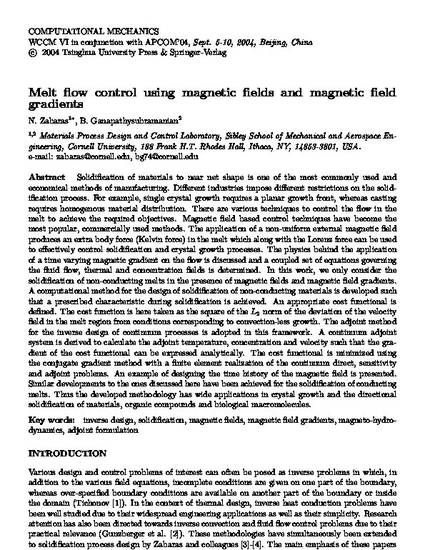
Presentation
Melt flow control using magnetic fields and magnetic field gradients
World Congress on Computational Mechanics (WCCM VI) in conjunction with the Second Asian-Pacific Congress on Computational Mechanics (APCOM '04)
(2004)
Abstract
Solidification of materials to near net shape is one of the most commonly used and
economical methods of manufacturing. Different industries impose different restrictions on the solidification
process. For example, single crystal growth requires a planar growth front, whereas casting
requires homogenous material distribution. There are various techniques to control the flow in the
melt to achieve the required objectives. Magnetic field based control techniques have become the
most popular, commercially used methods. The application of a non-uniform external magnetic field
produces an extra body force (Kelvin force) in the melt which along with the Lorenz force can be used
to effectively control solidification and crystal growth processes. The physics behind the application
of a time varying magnetic gradient on the flow is discussed and a coupled set of equations governing
the fluid flow, thermal and concentration fields is determined. In this work, we only consider the
solidification of non-conducting melts in the presence of magnetic fields and magnetic field gradients.
A computational method for the design of solidification of non-conducting materials is developed such
that a prescribed characteristic during solidification is achieved. An appropriate cost functional is
defined. The cost function is here taken as the square of the L2 norm of the deviation of the velocity
field in the melt region from conditions corresponding to convection-less growth. The adjoint method
for the inverse design of continuum processes is adopted in this framework. A continuum adjoint
system is derived to calculate the adjoint temperature, concentration and velocity such that the gradient
of the cost functional can be expressed analytically. The cost functional is minimized using
the conjugate gradient method with a finite element realization of the continuum direct, sensitivity
and adjoint problems. An example of designing the time history of the magnetic field is presented.
Similar developments to the ones discussed here have been achieved for the solidification of conducting
melts. Thus the developed methodology has wide applications in crystal growth and the directional
solidification of materials, organic compounds and biological macromolecules.
Keywords
- solidification,
- magnetic fields,
- magnetic field gradients,
- magneto-hydrodynamics,
- adjoint formulation,
- inverse design
Disciplines
Publication Date
2004
Location
Beijing, China
Comments
This is a manuscript of a conference proceeding from Computational Mechanics WCCM VI in conjunction with APCOM 4 (2004): 5-10. Posted with permission.
Citation Information
Nicholas Zabaras and Baskar Ganapathysubramanian. "Melt flow control using magnetic fields and magnetic field gradients" World Congress on Computational Mechanics (WCCM VI) in conjunction with the Second Asian-Pacific Congress on Computational Mechanics (APCOM '04) (2004) Available at: http://works.bepress.com/baskar-ganapathysubramanian/49/
